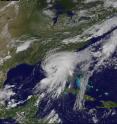Hermine becomes a hurricane in the Gulf of Mexico
Tropical Storm Hermine officially reached hurricane status on Thursday, Sept. 1, 2016, at 1:55 p.m. EDT. NOAA's GOES-East satellite captured a visible image of the hurricane at 3:15 p.m. EDT (1915 UTC). The image shows a much more organized Hermine with bands of thunderstorms wrapping around its low-level center and blanketing the entire state of Florida. The image was created at NASA/NOAA's GOES Project office, NASA's Goddard Space Flight Center in Greenbelt, Maryland.
A hurricane warning is in effect from Suwannee River to Mexico Beach, Florida. A hurricane watch is in effect from Anclote River to Suwannee River, and west of Mexico Beach to the Walton/Bay County line.
A tropical storm warning is in effect from Englewood to Suwannee River, from west of Mexico Beach to the Walton/Bay County line, and the Flagler/Volusia County line to Surf City. A tropical storm watch is in effect from north of Surf City to Oregon Inlet, including Pamlico Sound.
At 1:55 p.m. EDT (1755 UTC), the center of Hurricane Hermine was located near 28.1 degrees north latitude and 85.1 degrees west longitude. Hermine is moving toward the north-northeast near 14 mph (22 kph), and this motion with a slight increase in forward speed is expected during the next day or so. On the forecast track, the center of Hermine will be near the Florida coast in the hurricane warning area tonight or early Friday, Sept. 2.
Maximum sustained winds are near 75 mph (120 kph) with higher gusts. Tropical-storm-force winds extend outward up to 185 miles (295 km), mainly to the northeast and southeast of the center.
For updated forecasts, visit NHC's website at: http://www.nhc.noaa.gov.
Source: NASA/Goddard Space Flight Center
Articles on the same topic
- NASA takes parting look at HermineThu, 8 Sep 2016, 16:06:53 UTC
- NASA sees post-Tropical Storm Hermine south of Long Island, last advisory issuedThu, 8 Sep 2016, 16:06:33 UTC
- NASA sees post-Tropical Cyclone Hermine linger over northeastern USThu, 8 Sep 2016, 16:06:22 UTC
- NASA animation shows landfall and progression of Hurricane HermineFri, 2 Sep 2016, 16:06:38 UTC
- NASA sees Hermine's twin towersFri, 2 Sep 2016, 15:07:34 UTC
- NASA's GPM sees increasingly organized Tropical Storm HermineThu, 1 Sep 2016, 16:35:23 UTC
Other sources
- NASA takes parting look at Herminefrom PhysorgThu, 8 Sep 2016, 16:01:44 UTC
- Scientists use undersea drones to help predict hurricanesfrom PhysorgThu, 8 Sep 2016, 7:31:28 UTC
- Scientists use undersea drones to help predict hurricanesfrom AP ScienceThu, 8 Sep 2016, 5:11:14 UTC
- NASA sees post-Tropical Storm Hermine south of Long Island, last advisory issuedfrom PhysorgWed, 7 Sep 2016, 16:31:20 UTC
- NASA sees post-Tropical Cyclone Hermine linger over northeastern USfrom PhysorgTue, 6 Sep 2016, 20:21:17 UTC
- Post-tropical cyclone Hermine moving toward northeast U.S.from UPITue, 6 Sep 2016, 2:11:21 UTC
- Hermine's storm surge threat shifts to New England coastfrom UPIMon, 5 Sep 2016, 14:31:13 UTC
- Forecasters: Hermine could reach hurricane strength again in Northeastfrom UPISun, 4 Sep 2016, 14:21:16 UTC
- Hermine kills two, ruins beach weekends in northward marchfrom PhysorgSun, 4 Sep 2016, 10:31:30 UTC
- Tropical Storm Hermine maintaining strength as it continues up East Coastfrom UPISat, 3 Sep 2016, 13:31:20 UTC
- Hurricane Season Is Heating Up. So Is the Planet. Coincidence?from NY Times ScienceSat, 3 Sep 2016, 0:21:13 UTC
- Hermine: Storm over Carolinas as Florida cleans up; 1 dead; 250K without powerfrom UPISat, 3 Sep 2016, 0:01:18 UTC
- NASA animation shows landfall and progression of Hurricane Herminefrom PhysorgFri, 2 Sep 2016, 16:01:19 UTC
- NASA sees Hermine's twin towersfrom PhysorgFri, 2 Sep 2016, 15:31:15 UTC
- Hurricane Hermine makes landfall on Florida's Gulf Coastfrom UPIFri, 2 Sep 2016, 10:01:18 UTC
- UW-Madison Scientists Help Fly Global Hawk Drone Into Hermine, Other Hurricanesfrom Newswise - ScinewsFri, 2 Sep 2016, 8:41:21 UTC
- Hurricane Hermine begins assault on Florida's Gulf Coastfrom UPIFri, 2 Sep 2016, 8:11:17 UTC
- Florida facing 'life-threatening' conditions as Hurricane Hermine approachesfrom UPIThu, 1 Sep 2016, 22:31:27 UTC
- Hurricane Hermine Threatens Florida in New Photo from Spacefrom Space.comThu, 1 Sep 2016, 22:11:16 UTC
- Hermine becomes a hurricane in the Gulf of Mexicofrom PhysorgThu, 1 Sep 2016, 21:31:18 UTC
- Hurricane Hermine Threatens Florida in New Photo from Spacefrom Live ScienceThu, 1 Sep 2016, 21:21:19 UTC
- NASA's GPM sees increasingly organized Tropical Storm Herminefrom PhysorgThu, 1 Sep 2016, 16:31:33 UTC
- Florida woman spots alligator swimming down flooded streetfrom UPIThu, 1 Sep 2016, 13:31:28 UTC
- Hurricane warnings for Florida panhandle as Tropical Storm Hermine takes aimfrom UPIThu, 1 Sep 2016, 11:01:48 UTC
- Tropical Storm Hermine picking up steam in Gulf; Florida declares emergenciesfrom UPIWed, 31 Aug 2016, 19:01:19 UTC
- Florida men facing felony charge over viral video of bare-handed alligator capturefrom UPIWed, 31 Aug 2016, 13:31:25 UTC
- Tropical Depression 9 could become hurricane before reaching Floridafrom UPIWed, 31 Aug 2016, 12:01:20 UTC
